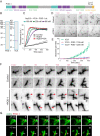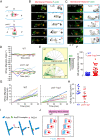Actin filament debranching regulates cell polarity during cell migration and asymmetric cell division
- PMID: 34507987
- PMCID: PMC8449360
- DOI: 10.1073/pnas.2100805118
Actin filament debranching regulates cell polarity during cell migration and asymmetric cell division
Abstract
The formation of the branched actin networks is essential for cell polarity, but it remains unclear how the debranching activity of actin filaments contributes to this process. Here, we showed that an evolutionarily conserved coronin family protein, the Caenorhabditis elegans POD-1, debranched the Arp2/3-nucleated actin filaments in vitro. By fluorescence live imaging analysis of the endogenous POD-1 protein, we found that POD-1 colocalized with Arp2/3 at the leading edge of the migrating C. elegans neuroblasts. Conditional mutations of POD-1 in neuroblasts caused aberrant actin assembly, disrupted cell polarity, and impaired cell migration. In C. elegans one-cell-stage embryos, POD-1 and Arp2/3, moved together during cell polarity establishment, and inhibition of POD-1 blocked Arp2/3 motility and affected the polarized cortical flow, leading to symmetric segregation of cell fate determinants. Together, these results indicate that F-actin debranching organizes actin network and cell polarity in migrating neuroblasts and asymmetrically dividing embryos.
Keywords: actin debranching; cell polarity; coronin; directional cell migration.
Conflict of interest statement
The authors declare no competing interest.
Figures





Similar articles
-
Spatial confinement of receptor activity by tyrosine phosphatase during directional cell migration.Proc Natl Acad Sci U S A. 2020 Jun 23;117(25):14270-14279. doi: 10.1073/pnas.2003019117. Epub 2020 Jun 8. Proc Natl Acad Sci U S A. 2020. PMID: 32513699 Free PMC article.
-
A Formin Homology protein and a profilin are required for cytokinesis and Arp2/3-independent assembly of cortical microfilaments in C. elegans.Curr Biol. 2002 Dec 23;12(24):2066-75. doi: 10.1016/s0960-9822(02)01355-6. Curr Biol. 2002. PMID: 12498681
-
The branched actin nucleator Arp2/3 promotes nuclear migrations and cell polarity in the C. elegans zygote.Dev Biol. 2011 Sep 15;357(2):356-69. doi: 10.1016/j.ydbio.2011.07.008. Epub 2011 Jul 18. Dev Biol. 2011. PMID: 21798253 Free PMC article.
-
Control of polarized assembly of actin filaments in cell motility.Cell Mol Life Sci. 2015 Aug;72(16):3051-67. doi: 10.1007/s00018-015-1914-2. Epub 2015 May 7. Cell Mol Life Sci. 2015. PMID: 25948416 Free PMC article. Review.
-
Roles of Actin in the Morphogenesis of the Early Caenorhabditis elegans Embryo.Int J Mol Sci. 2020 May 21;21(10):3652. doi: 10.3390/ijms21103652. Int J Mol Sci. 2020. PMID: 32455793 Free PMC article. Review.
Cited by
-
The stabilization of Arp2/3 complex generated actin filaments.Biochem Soc Trans. 2024 Feb 28;52(1):343-352. doi: 10.1042/BST20230638. Biochem Soc Trans. 2024. PMID: 38288872 Free PMC article. Review.
-
Contractile ring mechanosensation and its anillin-dependent tuning during early embryogenesis.Nat Commun. 2023 Dec 8;14(1):8138. doi: 10.1038/s41467-023-43996-4. Nat Commun. 2023. PMID: 38065974 Free PMC article.
-
Direct observation of cortactin protecting Arp2/3-actin filament branch junctions from GMF-mediated destabilization.Eur J Cell Biol. 2024 Mar;103(1):151378. doi: 10.1016/j.ejcb.2023.151378. Epub 2023 Dec 5. Eur J Cell Biol. 2024. PMID: 38071835 Free PMC article.
-
Nuclear Actin Polymerization Regulates Cell Epithelial-Mesenchymal Transition.Adv Sci (Weinh). 2023 Oct;10(28):e2300425. doi: 10.1002/advs.202300425. Epub 2023 Aug 11. Adv Sci (Weinh). 2023. PMID: 37566765 Free PMC article.
-
The Actin Regulators Involved in the Function and Related Diseases of Lymphocytes.Front Immunol. 2022 Mar 16;13:799309. doi: 10.3389/fimmu.2022.799309. eCollection 2022. Front Immunol. 2022. PMID: 35371070 Free PMC article. Review.
References
-
- St Johnston D., Establishing and transducing cell polarity: Common themes and variations. Curr. Opin. Cell Biol. 51, 33–41 (2018). - PubMed
-
- Inagaki N., Katsuno H., Actin waves: Origin of cell polarization and migration? Trends Cell Biol. 27, 515–526 (2017). - PubMed
-
- Krause M., Gautreau A., Steering cell migration: Lamellipodium dynamics and the regulation of directional persistence. Nat. Rev. Mol. Cell Biol. 15, 577–590 (2014). - PubMed
-
- Rodal A. A., et al. ., Conformational changes in the Arp2/3 complex leading to actin nucleation. Nat. Struct. Mol. Biol. 12, 26–31 (2005). - PubMed
Publication types
MeSH terms
Substances
LinkOut - more resources
Full Text Sources
Other Literature Sources
Research Materials

